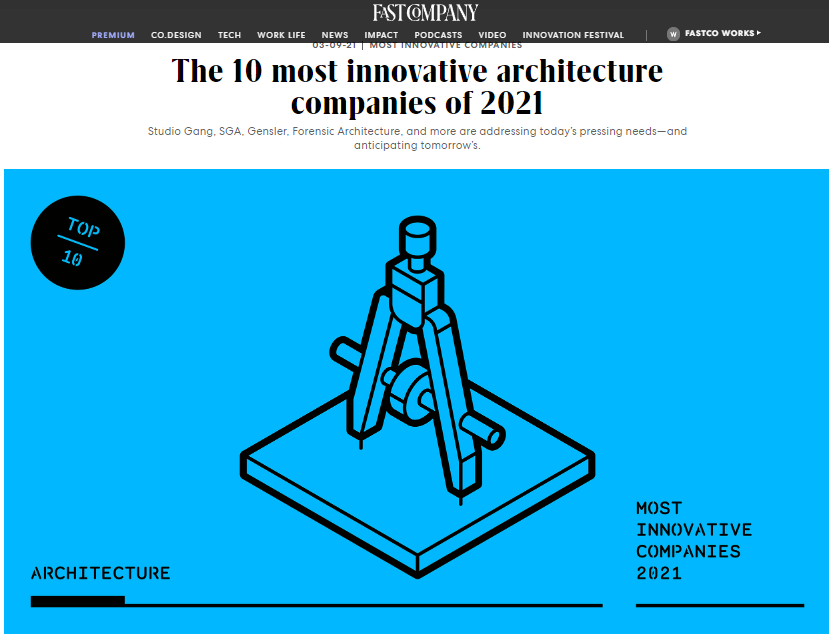Fast Company: Turenscape - The 10 most innovative architecture companies of 2021

For an industry accustomed to working with timelines that span several years into the future, architecture spent 2020 decidedly rooted in the present, as COVID-19—and its economic fallout—stalled or killed scores of projects. But that didn’t stop many firms from finding ways to put their design skills to work. Some responded specifically to the pandemic, others adapted their skillsets in the face of pressing needs, and yet others pushed relentlessly forward on stellar new projects that show the increasingly thoughtful work the profession continues to produce.
1. MASS DESIGN GROUP
For applying hospital expertise during the pandemic’s peak
As inventive as it is unconventional, MASS Design Group took a unique approach to architecture this year, delivering design intelligence in the madness of the pandemic. The collective’s not-for-profit model has led to ambitious hospital designs in developing countries; last year they applied their skills, and style, to helping hospitals such New York’s Mt. Sinai adapt their spaces to respond to peak pandemic patient loads.
2. STUDIO GANG
For baking permanently affordable housing into the residential high-rise
When it began working on the elegantly twisting MIRA residential tower in downtown San Francisco, Studio Gang saw an opportunity to add more than just density to the city center. The firm proposed adding 100 extra feet to the project, and using some of the additional space for much-needed affordable housing. City officials unanimously agreed. The recently completed 400-foot high-rise now has 44 more housing units that will remain affordable in perpetuity.
3. DILLER SCOFIDIO + RENFRO
For designing one of the world’s most accessible museums
A structure of bold origami-like folds, the new U.S. Olympic & Paralympic Museum in Colorado Springs was designed by Diller Scofidio + Renfro with a simple but powerful aspiration: to be accessible to all who visit. That led to its spiraling interior layout, informed by input from Paralympians, which enables visitors of all abilities to wind their way through its galleries on a common path. “That simple gesture of connectivity was the biggest architectural idea of the project,” says DS+R partner Benjamin Gilmartin. DS+R’s architects extended the museum’s focus on accessibility into the neighboring community with a sculptural steel pedestrian bridge that was prefabricated and then hoisted into place. Though notable for its technology and fabrication, the metal scales on the building’s exterior offer no shortage of flash, either.
4. TURENSCAPE
For balancing China’s hyperspeed urbanization with green “sponge cities”
With projects in more than 200 cities, China’s most famous landscape architecture firm is counter-balancing the country’s hyperspeed urbanization with its ecology-based “sponge city” projects..
5. LA MÁS
For pivoting community-focused design to community-centric aid
Working with largely underserved populations in Los Angeles, LA Más has brought high quality design to simple and low-budget projects like backyard houses and community-driven streetscape improvements. In 2020, the planners and designers channeled their policy know-how toward rallying aid to the local community, using their connections to public agencies and the non-profit world to launch a free weekly food and resource distribution program.
6. KURANI
For designing projects for small groups in need and helping find sponsors
Most architecture clients are wealthy, but not all of them. Kurani has developed a unique sponsor-based funding solution for cash-strapped and non-profit organizations. Kurani designs projects for small groups in need of architecture, and then works with them to find sponsors. The firm is both designer and fundraiser, and it has lured contributions from major sports franchises, entertainment, groups and some of the biggest companies in Silicon Valley.
7. FORENSIC ARCHITECTURE
For using architectural skills to reveal hidden truths
After a massive explosion at the port of Beirut devastated a significant part of the city, the technology-centric research agency Forensic Architecture began collecting and analyzing video and data to understand how and why it happened. Using the skills and tools architects possess to model smoke plumes, port buildings, and the interiors of warehouses, they were able to discern that the improper storage of harmful chemicals, and governmental negligence, led to the blast.
8. SGA
For future-proofing life sciences buildings for any new scientific challenges
Specialists in designing flexible life sciences spaces that can adapt to new technology and conditions, SGA’s approach to architecture has become vital in the age of the pandemic. In the designs it’s created over the past year for more than 4 million square feet of new life science facilities in Greater Boston, SGA has applied some of the lessons of the pandemic to create spaces with movable cabinetry and modular mechanical systems where researchers and scientists can quickly adapt to changing conditions and global needs – buildings that are ready for whatever scientific challenges lie ahead.
9. BLACKSPACE
For integrating Black voices into the design process
Working within the often very white world of urban development, this Black design collective of urban planners, designers, and architects is bringing Black voices and concerns into architecture and planning projects that affect and represent their communities. When protests over racial inequity and police violence spread across the country last summer, the nonprofit was more than ready to respond, organizing community participation efforts and centering communities of color in the creation process for a major Black Lives Matter mural in Manhattan.
10. GENSLER
For developing planning tools to model buildings for a diverse world
Many architecture firms used the forced pause of the past year to beef up their internal tools for planning and computational design, and Gensler‘s are the most notable. Its proprietary tools enable designers to quickly develop data-driven designs for neighborhoods, buildings, and interiors. One, which helps visualize the human scale of finished projects, features an extra wide assortment of images, to help reflect the diversity of people whom their designs will eventually serve
A version of this article appeared in the March/April 2021 issue of Fast Company magazine.
Source: https://www.fastcompany.com/90600111/architecture-most-innovative-companies-2021
